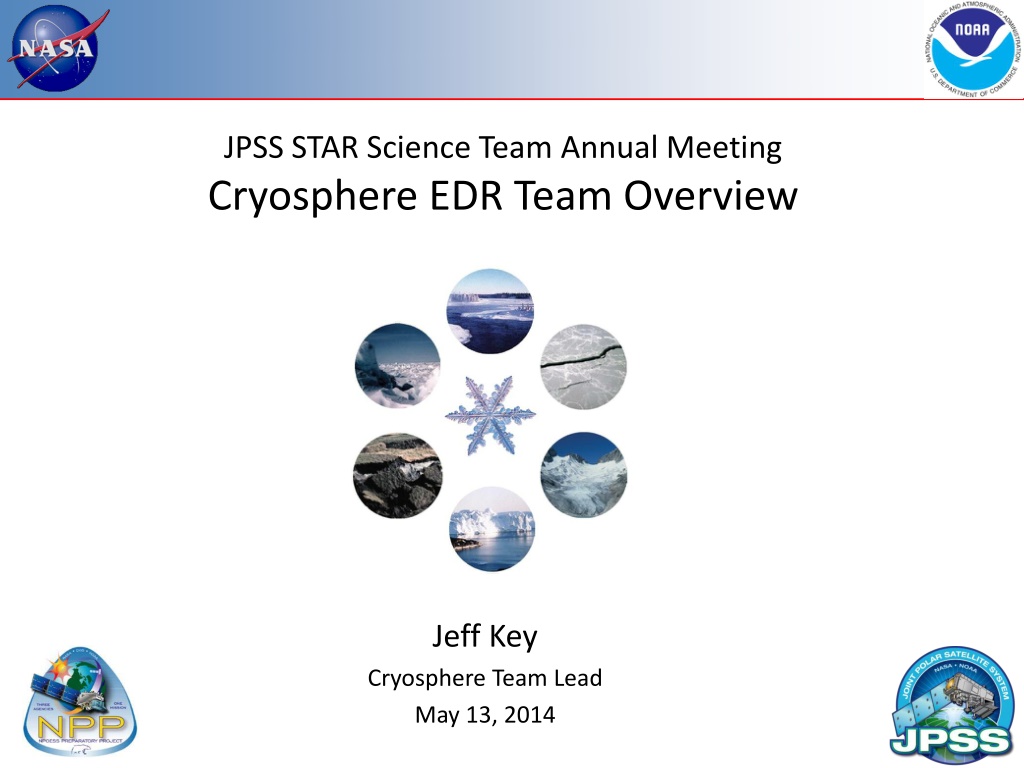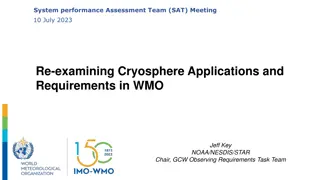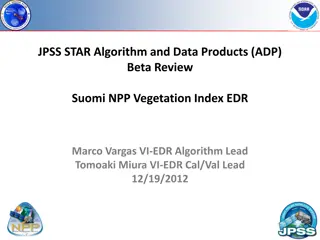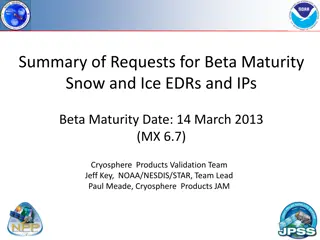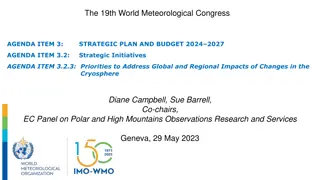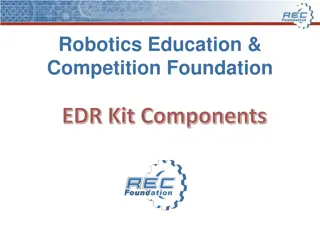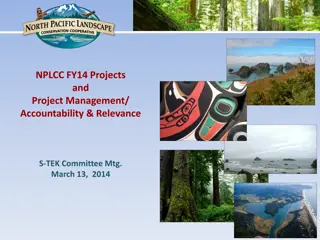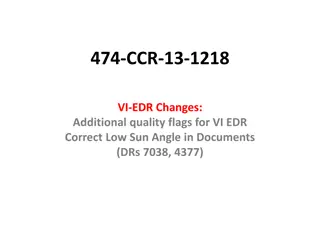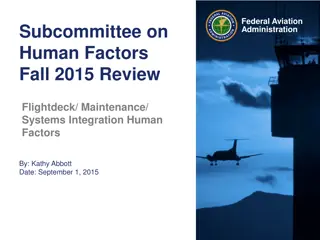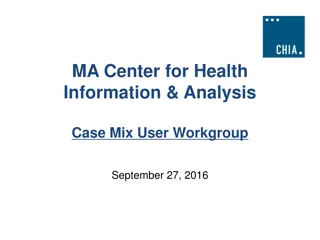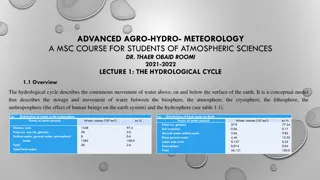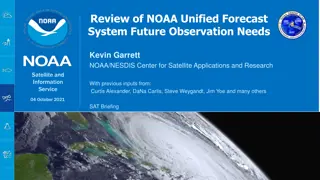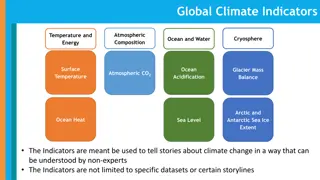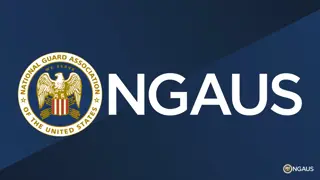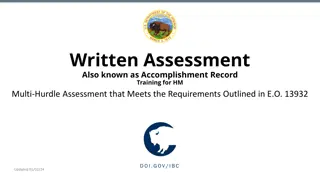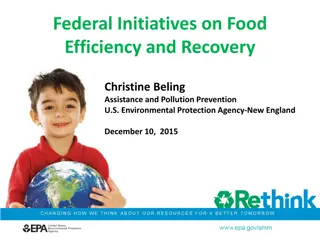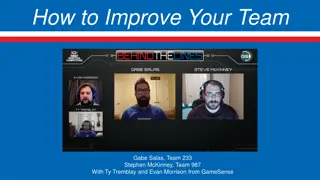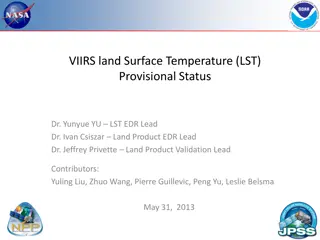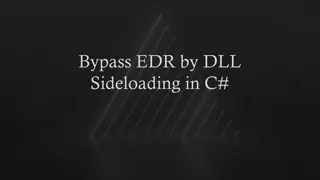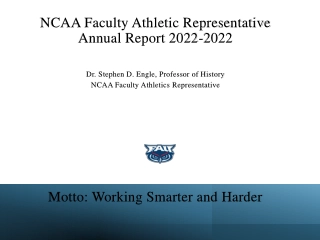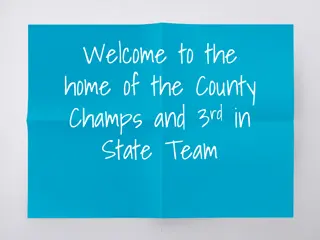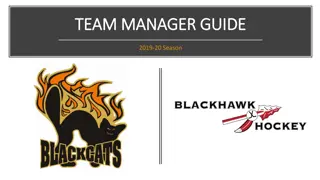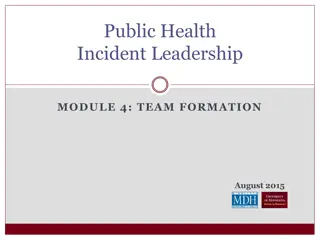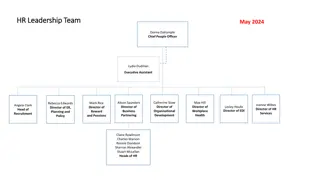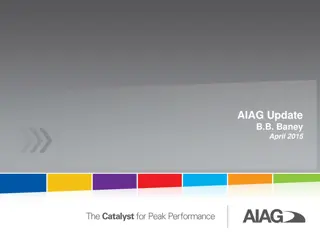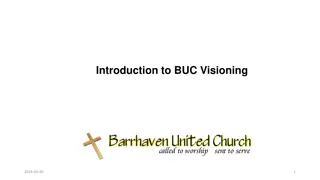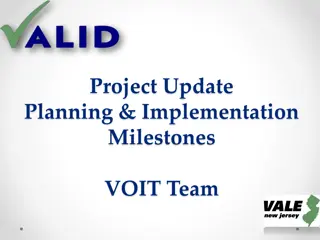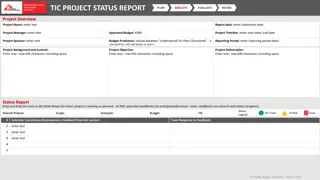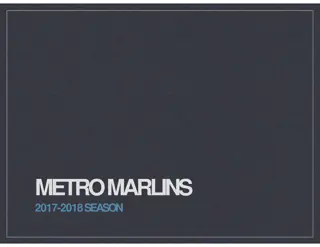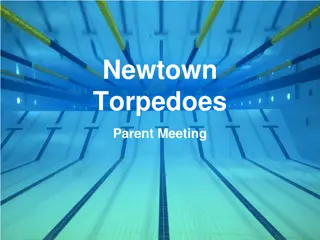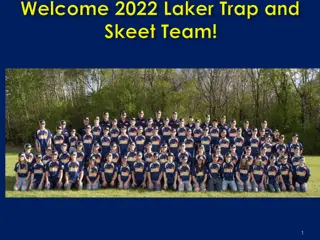Cryosphere EDR Team Overview and Accomplishments in FY14
The Cryosphere EDR Team shared insights on their data products including sea ice characterization, ice surface temperature, snow cover, and more at the JPSS STAR Science Team Annual Meeting in May 2014. Lead by Jeff Key, the team outlined their membership, funding sources, and user base. They highlighted accomplishments such as maturity reviews, technical meetings, and validation studies for snow and ice products. Collaborations with various organizations and continual improvements in product validation were also mentioned.
Download Presentation

Please find below an Image/Link to download the presentation.
The content on the website is provided AS IS for your information and personal use only. It may not be sold, licensed, or shared on other websites without obtaining consent from the author. Download presentation by click this link. If you encounter any issues during the download, it is possible that the publisher has removed the file from their server.
E N D
Presentation Transcript
JPSS STAR Science Team Annual Meeting Cryosphere EDR Team Overview Jeff Key Cryosphere Team Lead May 13, 2014
Overview of Data Products 1. Sea ice characterization Currently this is an age category: no ice, new/young ice, other ice 2. Sea Ice concentration IP Fractional coverage of ice in each pixel 3. Ice surface temperature (IST) Radiating temperature of the surface (ice with or without snow) 4. Snow cover 4a. Binary snow cover 4b. Fractional snow cover (currently 2x2 averages of binary mask) RGB Image shows dense smoke (high absorption) in northwest, north central and central coastal portions of image. Notes: Information on ice and snow cover is needed by other EDRs. AMSR2 on GCOM-W1 will be used to generate other snow and ice products: Ice Characterization, Snow Cover, Snow Depth, and Snow Water Equivalent (SWE). 2
Cryosphere Team Membership and Funding EDR Name Organization Lead Jeff Key NESDIS/STAR Co-Lead Pablo Clemente-Col n NESDIS/STAR and NIC Wisconsin: Ice Yinghui Liu CIMSS/U. Wisconsin Ice Xuanji Wang CIMSS/U. Wisconsin Ice Maryland: Rich Dworak CIMSS/U. Wisconsin Snow Peter Romanov CREST/CCNY Snow Igor Appel IMSG Colorado: Ice Mark Tschudi U. Colorado Ice Dan Baldwin U. Colorado Other: All Paul Meade DPE 3 All Robert Mahoney NGAS
Snow and Ice Product Users U.S. Users NIC, National/Naval Ice Center Naval Research Laboratory NWS, National Weather Service, including the Alaska Ice Desk OSPO, Office of Satellite and Product Operations STAR, Center for Satellite Applications and Research University of Washington, Polar Science Center GSFC, NASA/Goddard Space Flight Center Hydrological Sciences Branch User Community Navigation Emergency Management Operational Weather Prediction Climate Research DOD 4
Cryosphere Accomplishments for FY14 Maturity reviews: IST: Provisional, Validated Stage 1 Sea Ice Characterization: Provisional Snow Cover: Provisional, Validated Stage 1 for binary CCRs: 10 Three Technical Interchange Meetings (TIMs) were held. Improved gridding significantly and made recommendations, though more could be done. Completed new, comprehensive validation studies for snow and ice products with in situ, aircraft, and satellite products. Automated validation is in place for some products. Implemented and began testing new fractional snow cover algorithm. Provided Land Team with help on update of the Surface Type EDR to perform a fall back to use the granulation of the gridded snow ice tiles. Published paper on snow and ice products and validation (JGR special issue). See the breakout session presentations for more accomplishments and details!
Sea Ice Characterization Description: An ice age classification for the categories: Ice -free, New/Young Ice (less than 30 cm thickness), and All Other ice. Freshwater ice is not included. Sea ice characterization composite for 17 December 2012 New/young ice (less than 30 cm) is blue; older ice is green.
VIIRS Sea Ice Characterization EDR L1RD Requirements Sea Ice Characterization Requirements from L1RD version 2.4 EDR Attribute Threshold Objective a. Vertical Coverage Ice Surface Ice Surface b. Horizontal Cell Size 1. Clear 2. All weather 1.0 km No capability 0.5 km 1 km c. Mapping Uncertainty, 3 sigma 1. Clear 2. Cloudy 5 km No capability 0.5 km 1 km d. Measure Range 1. Ice Age Ice free, Nilas, Gray White Grey, White, First Year Medium, First Year Thick, Second Year, Multiyear, Smooth and Deformed Ice Ice Free, New Young, all other ice 2. Ice Concentration 0/10 to 10/10 0/10 to 10/10 RGB Image shows dense smoke (high absorption) in northwest, north central and central coastal portions of image. 2. Ice Concentration f. Refresh e. Measurement Uncertainty 1. Probability of Correct Typing (Ice Age) 70% Note 1 90% 5% At least 90% coverage of the global every 24 hours (monthly average) 6 hrs g. Geographic coverage All Ice-covered regions of the global ocean All Ice-covered regions of the global ocean Notes: 1. VIIRS produces a sea ice concentration IP in clear sky conditions, which is provided as an input to the ice surface temperature calculation 7 7
Ice Characterization There are times when performance is good, and other times (too many) when performance is not good. Overall, it does not appear to be meeting the accuracy requirements. This is a complex algorithm where improvements may be required in a number of areas. 19:23 UTC 22:43 UTC Other Ice NY Ice Ice Free Cloud Land Region near Wrangle Island showed significant amounts of sea ice that were correctly classified as thicker Other Ice in 22:43 UTC orbit being misclassified as NY in the 19:23 UTC orbit 5/14/2014 8
Ice Surface Temperature Description: The surface (skin, or radiating) temperature of sea ice. Composite of VIIRS Ice Surface Temperature on 27 Feb 2012.
VIIRS IST EDR L1RD Requirements Ice Surface Temperature (IST) Requirements from L1RD Supplement. V2.9 (27 June 2013) EDR Attribute Threshold Objective IST Applicable Conditions 1. Clear, only a. Sensing Depth Ice Surface Ice Surface b. Horizontal Cell Size 1. Nadir 2. Worst Case 1 km 1.6 km 0.1 km 0.1 km c. Mapping Uncertainty, 3 sigma 1. Nadir 2. Worst Case 1 km 1.6 km 0.1 km 0.1 km d. Measure Range 213-275 K 213-293 K (2 m above ice) RGB Image shows dense smoke (high absorption) in northwest, north central and central coastal portions of image. e. Measurement Uncertainty 1 K f. Refresh At least 90% coverage of the global every 24 hours (monthly average) 12 hrs g. Geographic Coverage Ice-covered oceans All ice-covered waters 10 10
IceBridge KT19 vs VIIRS IST, 2012 BIAS = VIIRS - KT19 DATE KT19 VIIRS BIAS RMS 3/14 -33.71 -33.15 0.56 0.08 3/15 -32.22 -33.05 -0.84 0.63 3/16 -29.88 -28.87 1.01 0.71 3/21 -36.01 -36.56 -0.55 0.41 3/22 -34.45 -34.66 -0.21 0.14 3/27 -31.15 -31.02 0.12 0.21 3/28 -32.61 -31.49 1.12 0.53 3/29 -37.85 -37.39 0.46 0.10 4/02 -33.36 -32.70 0.66 0.19 VIIRS IST has a 0.5+ K cold bias relative to the MODIS Ice Surface Temperature product. Comparisons to NCEP and International Arctic Buoy Program (IABP) air temperatures yield a VIIRS warm bias of 1 K. It meets the accuracy requirement under most conditions. 11
Binary Snow Cover Description: Snow Cover is defined to be the horizontal and vertical extent of snow cover. The binary product gives a snow/no-snow flag. March 23, 2013 S-NPP VIIRS March 23, 2013 AVHRR METOP 12 12
Binary Snow Cover Requirements Parameter a. Binary Horizontal Cell Size, 1. Clear daytime (Worst case) 2. Clear daytime (At nadir) 3. Cloudy and/or nighttime b. Horizontal Reporting Interval c. Snow Depth Range d. Horizontal Coverage e. Vertical Coverage f. Measurement Range g. Probability of Correct Typing h. Mapping Uncertainty Specification Value 0.8 km 0.4 km N/A Horizontal Cell Size > 0 cm (Any Thickness) Land > 0 cm Snow / No snow 90% 1.5 km 1. The probability of correct snow/no-snow detection applies only to climatologically snow-covered regions. 2. The accuracy of snow detection does not apply over forested/mountainous areas where snow may be hidden by vegetation or topographic shading. [Joint Polar Satellite System (JPSS) Program Level 1 Requirements SUPPLEMENT Final Version: 2.9 June 27, 2013] 13 13
VIIRS, AVHRR, MODIS Snow vs IMS Mean agreement to IMS and cloud-clear fraction of daily automated snow products in 2013 Northern Hemisphere *Cloud-clear fraction is estimated in 25-600N latitude band Binary snow cover meets the accuracy requirement. Most issues are related to cloud masking; e.g., somewhat overestimated cloud extent and corrupted land/water mask. Some potential exists to improve the algorithm and the product, e.g., geometry- dependent threshold values.
Fractional Snow Cover VIIRS fraction Description: VIIRS Snow Cover Fraction is derived from the Binary Snow Map as an aggregated snow fraction within 2x2 pixel blocks. The spatial resolution of the product is 750 m at nadir Image MODIS fraction In 2x2 snow fraction (top) snow to no snow transition regions are unrealistically narrow compared to the MODIS based snow fractions. 15
Specification of VIIRS Snow Fraction Parameter Specification Value a. Horizontal Cell Size, 1. Clear daytime (Worst case) 1.6 km 2. Clear daytime (At nadir) 0.8 km 3. Cloudy and/or nighttime N/A b. Horizontal Reporting Interval Horizontal Cell Size c. Snow Depth Ranges > 0 cm (Any Thickness) d. Horizontal Coverage Land RGB Image shows dense smoke (high absorption) in northwest, north central and central coastal portions of image. f. Measurement Range e. Vertical Coverage > 0 cm 0 100% of HCS g. Measurement Uncertainty 10% of HCS (Snow/No Snow) h. Mapping Uncertainty 1.5 km 16 16
Snow Fraction Alternative Algorithms The 2x2 pixel aggregation scheme can only provide a small set of values (0, 25, 50, 75, 100% if no missing pixels) and therefore cannot meet the 10% accuracy requirement throughout the measurement range. A number of different snow fraction algorithms are available; the first two are being tested: 1. 2. 3. NDSI-based (Solomonson/Appel, Hall/Riggs) Visible reflectance based (Romanov/Tarpley) Multiple endmember multispectral approach (Painter) 17
Algorithm Recommendations Recommendations for IDPS algorithms: Product Through Aug 31 NPP after Aug 31 JPSS Sea Ice Concentration IP 1 1 1 or 3 Ice Surface Temperature 1 1 or 3 3 Sea Ice Characterization/age 1 1 or 2 (TBD) 2 or 3 Binary Snow Cover 1 1 1 or 3 Fractional Snow Cover 2 2 2 1. NPOESS algorithm has evolved into the NOAA-endorsed JPSS algorithm and any needed improvements should continue. 2. NPOESS (or evolved) algorithm will not meet requirements or effort is too large, replace with NOAA-endorsed JPSS algorithm 3. NOAA-endorsed algorithm should be used even if NPOESS (or evolved) algorithm meets performance because of legacy, enterprise, blended products, and other considerations.
VIIRS Snow/Ice Gridding Tests GMASI Ice over water Snow over land No Snow over land No Ice over water VIIIRS Updated Ice over water Snow over land No Snow over land No Ice over water Rich Dworak SSEC /UW 19
Snow/Ice Gridding Summary Improvements in the VIIRS gridded Snow/Ice have occurred due to the MX 7.2 VCM update and application of additional quality control criteria that included: 1. Extended cloud adjacency applied to Sea Ice Concentration IP 2. Standard cloud adjacency applied to Snow Cover EDR 3. Confidently clear pixels only 4. No thin cirrus 5. Solar zenith angle limited to angles less than 80 (cloud shadow issue) 6. Fallback to GMASI if no good quality VIIRS Snow/Ice after 5 days Sea Ice probability of detection and false alarm rate relative to NOAA AutoSnow for VIIRS gridded Sea Ice are approximately 87% and 7%, respectively, after testing with the proposed quality control criteria Significant regions were not updated by VIIRS Snow/Ice even after a 7 day gridding test period. Cloud shadows result in missing snow/ice in the Snow/Ice Rolling Tile grid. Further reduction in Snow/Ice gridding errors will require significant effort. 20
Cryosphere Team Challenges Unanticipated snow/ice gridding issues and problems have required the team to devote unscheduled resources. Gridding problems, including interactions with the cloud mask, have occupied all of our time and resources for the last 19 months. The team has had to spend a large amount of time on VCM issues, though there has been much improvement in the VCM and future work should be minimal. The FY14 budget is 30% less than FY13. The algorithm change process is cumbersome and lengthy. Too many steps and too much time for even the simplest of changes.
Plans, Milestones Suomi NPP JPSS J1 Validated Stage n (various) maturity reviews Implement, test, and deliver new fractional snow cover algorithm Continued validation of all products Improve or recommend replacement of Sea Ice Characterization algorithm Recommendations on snow/ice gridding JPSS Risk Reduction Projects: Run GOES-R algorithms on VIIRS products Minor algorithm improvements FY15 Hold algorithm preliminary design reviews Define validation plan Algorithm maintenance and minor improvements FY16 Hold algorithm critical design reviews Begin transitioning to JPSS Redefine products if needed Generate LUTs for J1 VIIRS sensor Long-term validation of VIIRS snow and ice products FY17 Long-term validation of VIIRS snow and ice products J1 launch Beta maturity status FY18
